2 Fundamentals of Problem-Solving Techniques and Project Management
In this chapter, first, we will introduce some problem-solving tools to be used in any type of problems either engineering design, business, or even in our day to day personal life. That includes problem solving tools to identify the problem, finding the cause of the problem, and finding the solution to the problem. Then, the fundamentals of project management will be presented at an introductory level. One should note that the objective of this chapter is to present the basics of problem-solving techniques and project management and introduce related key terms to junior undergrad college design students who don’t have previous background and experience and need to manage and document their capstone projects. Thus, covering both problem-solving techniques and project management areas are well beyond the scope of this text.
Problem-solving techniques: Problem Definition
The main objective of this step is to identify and develop the problem definition such that we have a clear understanding of problem at hand. This is a key step in the design process but most of the time is underestimated and undervalued by junior designers. Three available tools commonly used in this step are as follows: (i) brainstorming; (ii) affinity diagram; and (iii) Pareto chart.
Brainstorming
Brainstorming is a common method and a group activity to generate ideas used to either find solution(s) to an existing problem or define the problem and possible causes. The main objective of a brainstorming session is to generate high number of ideas. A typical brainstorming session includes a person who is facilitating the session and is often performed with sticky notes and a white board.
A few guidelines to ensure the brainstorming session is conducted efficiently:
- Don’t judge, reject, or evaluate any ideas at this point. Remember that the objective is to generate as many ideas as possible in this session.
- It is normal, and also recommended, to build upon the ideas on other’s ideas. Remember that the brainstorming is a group activity.
- Make sure the brainstorming environment is free of any risk, embarrassment, and restraint to insure the free-flowing of the ideas.
- Manage the time such that the team will end up with as many as possible ideas in a short period of time. Avoid any unnecessary discussion at this stage.
Affinity Diagram
If possible, the generated ideas can be also categorized into several groups for further discussion once all ideas are generated and recorded. The affinity diagram is a tool to organize the ideas based on some sort of similarities among generated ideas.
Pareto Chart (80/20 Rule)
Pareto chart is a bar chart representing the frequency of occurrence of several events used to prioritize the causes of a problem when the problem has more than one cause. The main outcome of Pareto chart is to identify few important causes resulting most of the problem as well as other insignificant causes. This is also called rule of 80/20.
Problem-solving techniques: Root Cause Finding
Once the problem at hand well understood, the next step will be to find the root cause(s) of the problem. To do that, we need to gather proper information as much as possible form various resources, then process and analyze them, and find the root cause(s) accordingly. Marketing tools such as communicating with customers, focus groups, surveys, and data analysis software can be used at this stage to gather the information. Three available tools to find the root cause(s) of the problem are as follows: (i) cause-and-effect diagram; (ii) why-why diagram; and (iii) interrelationship diagram.
Cause-and-effect Diagram
The cause-and-effect diagram is a tool to identify and represent the causes of a problem. An example of a typical cause-and-effect diagram is shown below. As shown, the main horizontal line represents the mainstream of collecting all causes of the problem at hand coming from different categories of causes. As one can see the brainstorming and affinity diagram techniques are inherently integrated to generate this diagram. It is also called fishbone diagram due to its final layout.
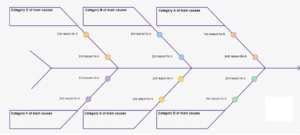
Why-Why Diagram
The why-why diagram can be considered as an alternative to the cause-and-effect diagram. It is used when we want to investigate one cause of problem in more depth. It starts with a general statement of the cause and then follows by questioning the cause by repeatedly asking “why?”. The procedure will continue until the root cause is clearly identified.
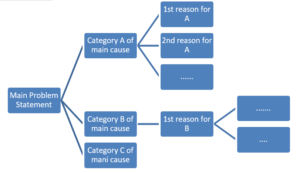
Interrelationship Diagram
The interrelationship diagram is used to explore the relationship among different causes identified by tools such as fishbone diagram, why-why diagram, or even those identified by the team members. As shown below, each circle represents one cause, and the arrows represent the relationship between the causes. The circle with most outgoing arrows represents the root cause and the circle with most incoming arrows represents the area that need to be monitored.
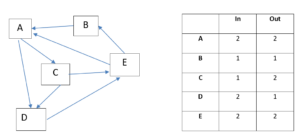
Introduction to Project Management
Project
A project is defined as a set of tasks and activities that are complex, non-routine, and one-time effort. It is limited by time, budget, and other resources. Its established objective(s) is to meet customer needs and required performance specifications. A project has a defined life span with a clear beginning and end.
Two Phases of Project Management
Project management is the activity of planning and coordinating resources and related tasks to achieve the goals of a project. Generally speaking the project management includes two major set of activities including: (i) project planning; and (ii) project control.
Project planning involves determining the required tasks and scheduling them to insure the project will be accomplished within its time limit and budget. It also involves identifying the required resources and allocate them properly to each task. Besides, it includes identifying the key tasks and milestones and arranging them in a proper sequence in which they should be performed.
Project control involves coordinating and facilitating the project tasks in the case of occurring unforeseen events and or in the face of new information or changes.
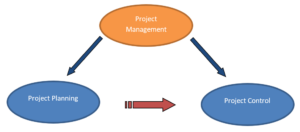
Project Life Cycle
A typical engineering project consists of main phases as follows:
- Defining
- Planning
- Executing
- Delivering
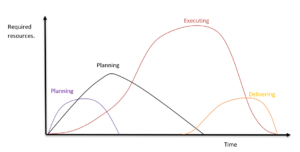
Project Proposal
Before any engineering work can be done, a proposal must be prepared. A project proposal typically includes the following headings:
| Item | Description |
| 1 | Reasons for Project |
| 2 | Terms of references – establish conditions and rules for doing the project, |
| 3 | Define assumptions, data, and design criteria |
| 4 | Cost of equipment / supplies and labour |
| 5 | Required resources |
| 6 | Project schedule |
| 7 | Outcome or benefits of the project (in terms of the rate of return, payback period, and annual cost savings etc. ) |
| 8 | System level design |
Recommended format of student proposal report
The following is a recommended format for a typical undergrad college student design project proposal. The assumption is that most students don’t have previous experience creating this kind of document. One should note that this suggested format can be customized depending on type of project at hand.
Introduction
- Cover page
- Abstract (Executive Summary)
- Table of contents
- List of Figures
- List of Tables
Section 1
- Problem statement
- Project objectives
- Project scope
- Project management and planning (WBS, Gant chart, Pert Chart)
Section 2
- Background, commercially available designs-products (benchmarking), literature review and external search
Section 3
- Concept generation/selection and concise discussion of:
- Customer needs identification (QFD or alternative)
- Functional decomposition diagram or alternative such as flowcharts
- Conceptual designs –sketch and description of each concept-,
- Decision making matrix,
Section 4
- System level design (Detailed Geometric layout and interaction graph).
- Project budget
- Risk plan
Appendices
- References
- Team Charter
- Tech spec.
Sequential, Parallel, and Coupled Tasks
As mentioned, the project planning involves scheduling the tasks and putting the plan into the time frame of the calendar. To do that, managing the order of the tasks to be accomplished is a key issue to consider. Generally speaking, all the required tasks in a typical project can be categorized into three groups as follows:
- Sequential tasks. As shown on the next page, tasks B and A are called sequential if task B is dependent on task A and output of task A is required to complete task B. One should note that task B can start with partial information/data but cannot be finished until task A has been completed.

- Parallel Tasks. The parallel tasks are dependent on the same task(s) but are independent of each other. For example, as shown below, tasks B and C are parallel.
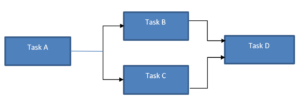
- Coupled Tasks. Coupled tasks are mutually dependent such that each task needs the result of the other tasks to be completed. For example, as shown below, tasks B, C and D are coupled. One should note that coupled tasks either must be executed at the same time with a continual flow of information or must be runed iteratively. Coupled tasks are most challenging type of tasks in project management. Two guidelines to complete the coupling tasks are to perform more iteration quickly or try to decouple tasks to avoid iterations if possible.
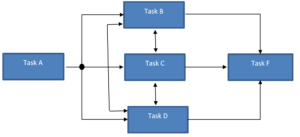
Work Breakdown Structure (WBS)
Work Breakdown Structure is a tool used to split a project into manageable sections such that the scope of the project and all required activities to complete the project is well understood and all required tasks are identified. The output of a typical Work Breakdown Structure is a list of phases and required tasks to be used in later project planning activities such as preparing a Gantt chart. The following example represents a WBS generated for a student project. As shown, each task is labelled to be conveniently used later on to create other project documents, if required.
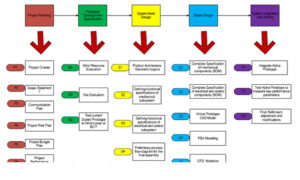
Gantt Chart
As the name suggests, Bar or Gantt Charts are developed using bars to represent each task. The length of the bar shows how long the task is expected to take to complete. Duration is easily shown on Gantt Charts.
One should note that while the duration of each task is clearly shown in the Gantt Chart, but the sequence between tasks can not be shown as illustrated on the next page.
Sequence is not well shown on Gantt Charts. If, for example, the start of Task C depends on both Activity B and Activity E, then any delay to Task E will also push Task C back. We just don’t have enough information on the Gantt chart to know this information.
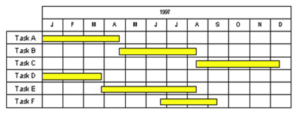
Critical Path Method (CPM)
CPM is a graphical network-based scheduling technique that is used commonly for managing projects. It uses network analysis to identify those tasks which are on a critical path, that is, where any delay in the completion of these tasks will lengthen the project time scale, unless action is taken.
For bigger projects, task inter-relationships can be quite complicated. Within these relationships, there is a continuous chain or chains of tasks from start to end that determine the longest total time needed to execute the project. It is called a critical path.
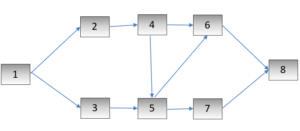
CPM is an effective method of assessing:
- Tasks which must be carried out,
- Where parallel activities can be carried out,
- The shortest time in which a project can be completed,
- Resources needed,
- Sequence of activities, scheduling, and timings involved,
- Task priorities.
Each task in a project has a certain time duration, start and finish dates. A degree of tolerance is possible (E.g. late start, late completion, early start, early completion). When combined, thesetasks will give an estimate for the total project duration.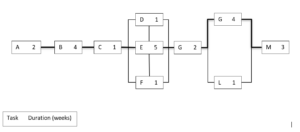
Feed Buffer and Project Buffer
Delays happen randomly during executing a project among non-critical and critical tasks. A project buffer is a safety time to be considered to compensate possible delays of project as a whole. On the other hand, the feeder buffer is a safety time to be considered to protect the critical path from delays of non-critical tasks as shown below.
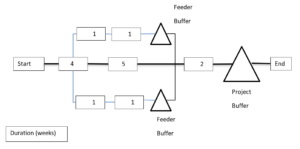
The following guidelines are suggested to avoid delays and accelerate the project:
- Start the project early.
- The project scope should be managed. Don’t try to make a project/product perfect.
- Try to facilitate the exchange of essential information more effectively.
- Minimize the number of tasks on the critical path, if possible.
- Minimize the delays related to preparing/providing required resources for the tasks on the critical path.
- Try to break up a single large task into smaller tasks where the outcome of each task can be passed along once they are available.
- Keep in your mind that you can outsource some of the tasks, if needed.
Recommended format of student final report
The following is a recommended format for a final report that can be used for a typical undergrad college student design project. The assumption is that most students don’t have previous experience creating this kind of document. One should note that this suggested format can be customized depending on type of project at hand.
- Cover page
- Abstract (Executive Summary)
- Table of contents
- List of Figures
- List of Tables
- Problem statement
- Project objectives
- Project scope
- Customer needs identification
- Background, commercially available designs-products (benchmarking), literature review and external search
- Concept generation and selection
- Functional decomposition diagram/analysis
- Conceptual designs – sketch and description of each concept-.
- Morphology
- Concept selection criteria/analysis, decision matrix,
- System level design sketch of selected concept (Detailed Geometric layout and interaction graph).
- Modeling and Simulation (CAD/CAE)
- Technical calculation
- Detailed Design (shop drawings -parts and assembly-, assembly plan, BOM)
- Cost Analysis
- Conclusion
- Future work
- Lessons learned.
- Project management and planning (WBS, Gant chart, Pert Chart)
- References
- Appendices

